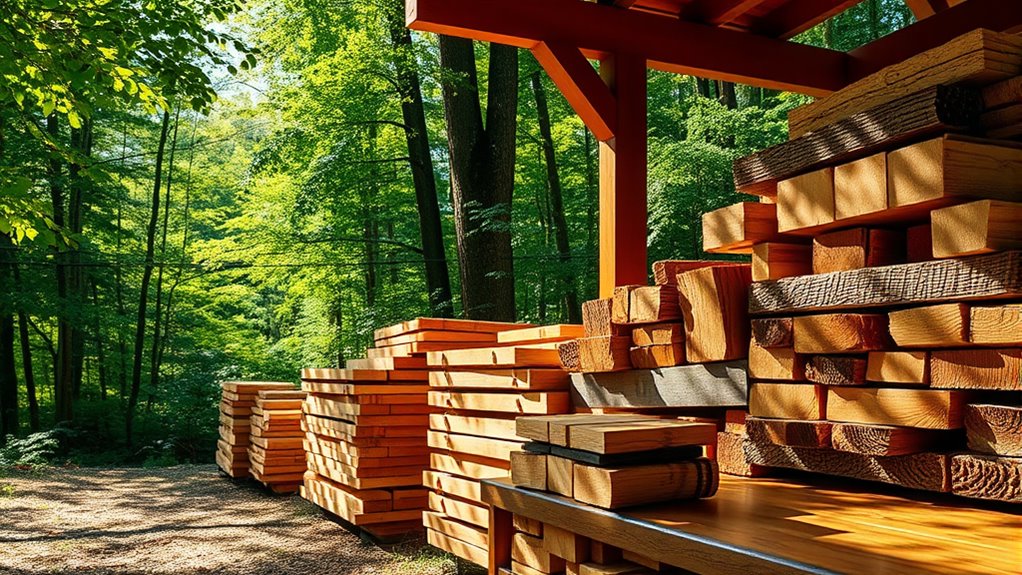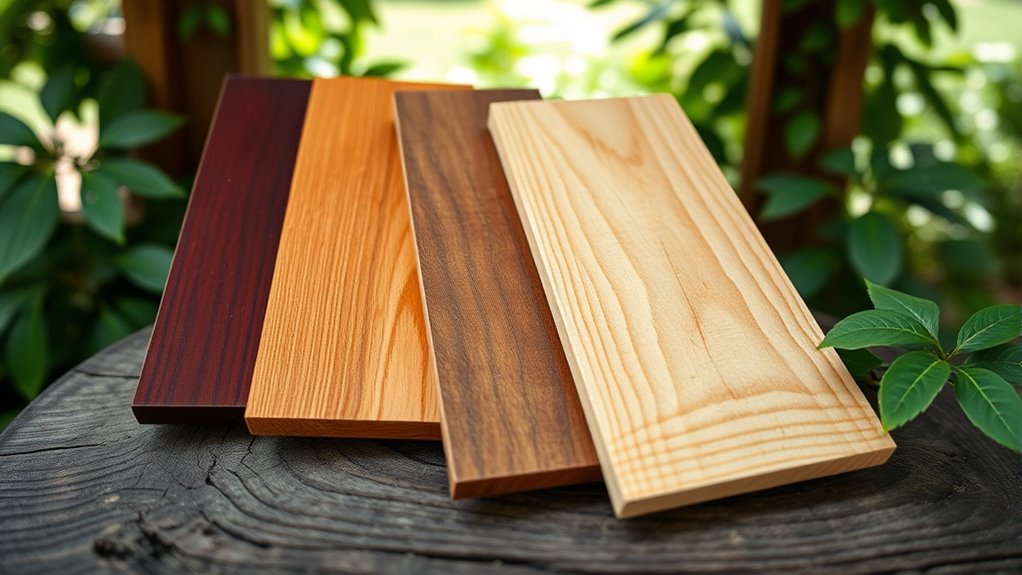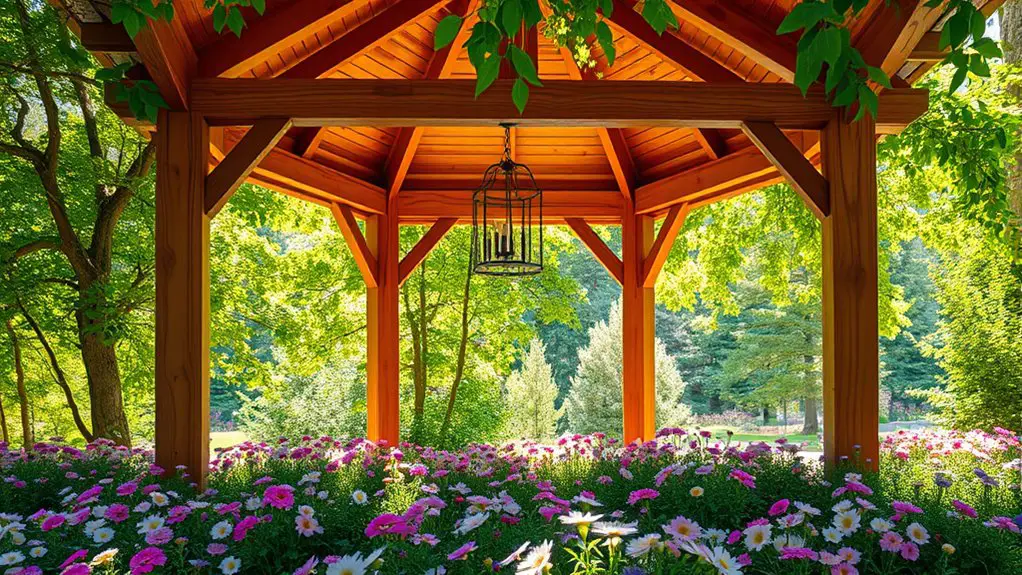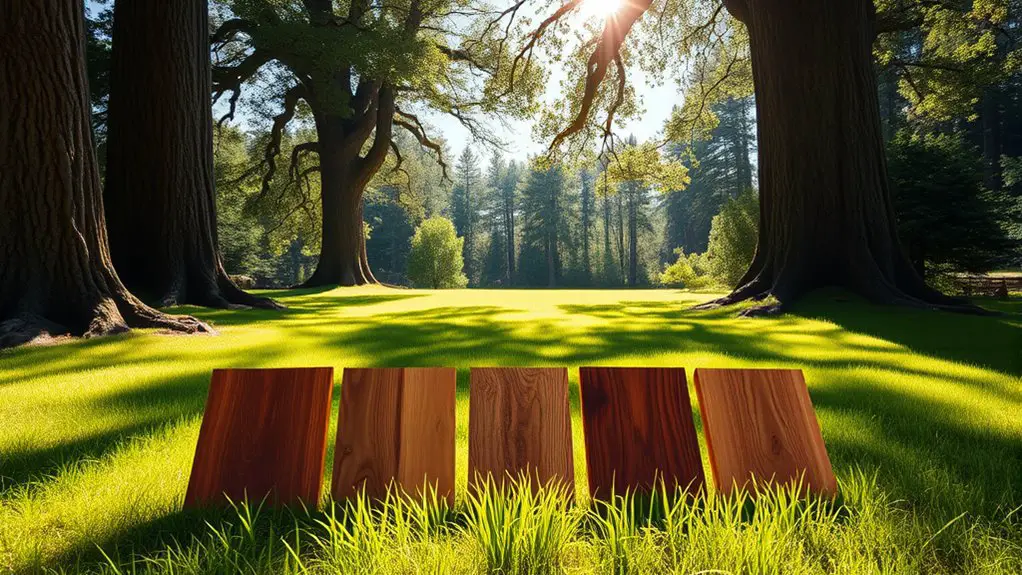To pick the right wood for a natural gazebo look, consider durability, weather resistance, and aesthetics. Opt for naturally decay-resistant options like cedar or redwood, which offer beautiful grains and require less maintenance. Hardwoods provide strength, while softwoods are budget-friendly but may need treatment. Keep an eye on color harmony and grain patterns to enhance visual appeal. By understanding your options, you can create a stunning structure that harmonizes with its surroundings. There’s much more to explore on this topic.
Understanding the Importance of Wood Selection

When selecting wood for your gazebo, it’s crucial to understand how different types of wood can affect both the structure’s durability and aesthetic appeal. Each wood type has unique properties; for instance, hardwoods like oak and teak offer strength and resistance to wear, while softwoods like pine are lighter and easier to work with. Consider the environmental impact of your choice as well. Sustainably sourced woods can minimize deforestation and support eco-friendly practices, aligning with your desire for freedom in nature.
Additionally, think about the wood’s ability to withstand weather conditions, as some types may require more maintenance than others. Pressure-treated wood can enhance longevity but may contain chemicals affecting the environment. By weighing these factors, you’ll make an informed decision that not only meets your aesthetic preferences but also respects the planet, ensuring your gazebo stands strong and beautiful for years to come. Moreover, choosing naturally resistant wood types can significantly reduce long-term maintenance and enhance the structure’s lifespan.
Key Characteristics to Look for in Gazebo Wood
After considering the importance of wood selection, it’s time to focus on the key characteristics that make wood suitable for your gazebo. When sourcing wood, you should prioritize durability, resistance to decay, and aesthetic appeal.
| Characteristic | Description | Importance |
|---|---|---|
| Durability | Ability to withstand environmental factors | Guarantees longevity |
| Resistance to Decay | Protection against fungi and insects | Reduces maintenance needs |
| Grain and Texture | Visual appeal and compatibility with design | Enhances overall aesthetics |
| Workability | Ease of cutting, shaping, and finishing | Facilitates construction |
Considering these wood properties will help you make an informed decision. Opting for quality wood not only enhances the gazebo’s beauty but also provides essential strength and longevity. Embrace the freedom of choosing the right materials for your outdoor haven. Additionally, selecting sustainable and eco-friendly materials can further enhance the gazebo’s impact on the environment.
Popular Wood Types for Gazebos

Selecting the right wood type for your gazebo is essential, as it can considerably impact both its longevity and visual appeal. Two popular choices are cedar and pine, each offering distinct advantages.
Cedar, with its natural resistance to decay and insects, provides long-lasting durability while featuring a beautiful grain that enhances the aesthetic of your structure. Its aromatic scent adds an inviting touch, making it ideal for outdoor spaces.
On the other hand, pine options are often more budget-friendly and versatile. While it may require treatment to resist moisture and pests, treated pine can still offer a charming rustic look. It’s easy to work with, allowing for creative designs and modifications. Additionally, proper maintenance needs for wood types like cedar and pine involve regular sealing, staining, or painting to protect against weathering.
Ultimately, your choice depends on your budget, aesthetic preferences, and maintenance willingness. Both cedar and pine can create a stunning gazebo, each catering to different needs and styles.
Evaluating Durability and Weather Resistance
While you might be drawn to the aesthetic qualities of wood for your gazebo, evaluating durability and weather resistance is essential for guaranteeing its longevity. Start by considering moisture resistance; some woods, like cedar and redwood, naturally repel water, making them less prone to warping and decay. On the other hand, softer woods may require treatments to enhance their moisture resistance.
Next, think about insect protection. Certain wood types, such as cypress and teak, contain natural oils that deter pests like termites. If you choose a less resistant wood, make sure you apply protective coatings or treatments to shield against insects.
Additionally, look for woods treated with preservatives for added durability. This will not only enhance their resistance to moisture and insects but also prolong their lifespan. By prioritizing these factors, you’ll create a gazebo that stands strong against the elements and offers lasting enjoyment. Furthermore, selecting eco-friendly wood options can contribute to sustainable building practices and reduce environmental impact.
Aesthetic Considerations for Your Gazebo Design

When designing your gazebo, the wood grain patterns and color choices play a vital role in its overall aesthetic appeal. Consider how the natural characteristics of the wood can enhance or complement your outdoor space. By selecting a harmonious color palette, you can create a visually striking structure that integrates seamlessly with its surroundings. Additionally, choosing materials that provide protection from harmful sun rays can enhance both the functionality and beauty of your gazebo design.
Wood Grain Patterns
As you consider the aesthetic appeal of your gazebo, the wood grain patterns can greatly influence the overall design and atmosphere. Different wood species offer unique grain variations that can enhance the visual interest of your structure. Here are some considerations to keep in mind:
- Straight Grain: Provides a classic, clean look, perfect for modern styles.
- Wavy or Curly Grain: Adds dynamic patterns that create a sense of movement.
- Interlocked Grain: Offers a more rustic feel, ideal for natural settings.
- Figured Grain: Unique patterns can serve as a focal point, showcasing craftsmanship.
Color Harmony Choices
Choosing the right colors for your gazebo can greatly impact its overall aesthetic, enhancing its integration into the surrounding environment. Start by selecting a cohesive color palette that reflects your personal style while harmonizing with natural elements. Consider the hues of nearby foliage, flowers, and structures. Complementary shades can elevate your gazebo’s design, creating a pleasing contrast that draws the eye without overwhelming the senses. For instance, pairing warm wood tones with cool greens can evoke a serene atmosphere. Additionally, think about finishes—stains and paints can alter the perception of color depth and richness. Ultimately, balancing colors will guarantee your gazebo not only stands out but also feels like a natural extension of your outdoor space.
Maintenance Requirements for Different Woods
When choosing wood for your gazebo, it’s essential to take into account the durability of different wood types and their specific maintenance needs. Hardwoods like teak and mahogany require less frequent treatments compared to softer woods, which may need regular sealing and staining to prevent decay. Understanding these maintenance requirements guarantees your gazebo remains both beautiful and functional for years to come.
Durability of Wood Types
The durability of wood types used in gazebos greatly impacts their long-term maintenance requirements. When evaluating wood longevity and weather exposure, you’ll want to weigh the pros and cons of various materials. Here are some key factors to take into account:
- Softwoods: Generally less durable and require more frequent maintenance.
- Hardwoods: Offer greater longevity but can be more expensive.
- Pressure-treated wood: Resistant to decay but may require special care over time.
- Natural options (like cedar or redwood): Naturally resistant to weather, but still need occasional treatment.
Understanding these aspects will help guarantee your gazebo not only looks stunning but also stands the test of time, allowing you to enjoy your outdoor space with minimal hassle.
Finishing and Treatment Needs
Different types of wood not only vary in durability but also in their finishing and treatment requirements. Hardwoods like teak and mahogany require specific finishing techniques to protect against moisture and UV damage. You’ll want to use a high-quality marine varnish or oil-based finish to enhance their natural beauty and longevity. Softwoods, such as pine or cedar, generally need regular treatment options like stains or sealers to prevent rot and insect damage. These finishes should be reapplied every couple of years. Consider the climate in your area, as it can dictate how often you’ll need to maintain your gazebo. Staying proactive with these treatments guarantees your structure remains not just beautiful but also resilient against nature’s elements.
Cost Analysis: Budgeting for Your Wood Choice
Budgeting for your wood choice in a gazebo project involves a careful evaluation of material costs, maintenance expenses, and long-term value. Proper cost estimation is essential for effective budget allocation, ensuring you don’t overspend while still achieving your desired aesthetic and durability.
Consider these key factors:
- Material Costs: Different woods have varying price points; choose wisely to balance quality and budget.
- Maintenance Expenses: Some woods require more upkeep, impacting long-term costs.
- Longevity: Investing in durable wood can save money on replacements and repairs.
- Resale Value: High-quality materials can enhance property value, offering a return on your initial investment. Additionally, selecting wood types such as naturally durable cedar wood can provide both aesthetic appeal and reduce maintenance costs.
Sustainable Wood Options for Eco-Friendly Gazebos
How can you create a beautiful gazebo while also being kind to the environment? The answer lies in choosing sustainable wood options. Look for timber sourced from sustainably managed forests, which guarantees that the ecosystem remains balanced and resources are renewed. Species like bamboo, reclaimed wood, or FSC-certified cedar offer eco-friendly alternatives that don’t compromise on aesthetics or durability.
Incorporating eco-friendly treatments is equally important. Opt for natural oils and water-based finishes that minimize environmental impact while enhancing the wood’s longevity. By selecting materials with sustainable sourcing and these treatments, you’re not just making a sound choice for your gazebo; you’re promoting a healthier planet. Additionally, consider the long-term environmental impact of your materials, as wooden gazebos require regular maintenance to stay in good shape.
Your gazebo can be a sanctuary that reflects your values—beauty and sustainability can coexist, giving you the freedom to enjoy nature without guilt. Choose wisely, and your outdoor retreat will harmoniously blend with the environment.
Tips for Treating and Preserving Your Gazebo Wood
While your gazebo may be a stunning addition to your outdoor space, proper treatment and preservation of the wood are essential to guarantee its longevity and beauty. Implementing effective wood treatment and preservation techniques will protect your investment for years to come. Here are some important tips:
- Choose a high-quality wood preservative: Opt for products that repel moisture and inhibit fungal growth.
- Apply a sealant: A clear sealant protects against UV rays while maintaining the natural look of the wood.
- Regular maintenance checks: Inspect for signs of wear or damage, and address issues promptly to prevent deterioration.
- Reapply treatments annually: Consistent upkeep will ensure your gazebo remains in pristine condition, enhancing its durability. Additionally, following seasonal care tips can help you adapt your maintenance routine throughout the year.
Frequently Asked Questions
What Is the Best Wood for Humid Climates?
In humid climates, you’ll want to contemplate tropical hardwoods like teak or mahogany for durability. Alternatively, pressure treated lumber offers protection against moisture, ensuring your structure withstands the elements while maintaining a natural aesthetic.
How Do I Match Wood Color With My Home?
To achieve wood color matching, assess your home’s exterior coordination. Consider tones in your siding, roofing, and trim. Choose wood that complements these shades, ensuring a cohesive appearance that enhances your home’s overall aesthetic harmony.
Can I Mix Different Wood Types for My Gazebo?
Yes, you can mix different wood types for your gazebo. Wood type combinations can enhance aesthetic appeal, providing a unique, personalized look. Just make certain the woods complement each other in color, grain, and durability for harmony.
What Tools Are Needed for Wood Cutting and Shaping?
To cut and shape wood effectively, you’ll need a saw, chisel, and sander. Don’t forget your safety equipment! Mastering various cutting techniques guarantees precision and enhances your freedom to create a stunning gazebo.
How Long Does It Take to Build a Wooden Gazebo?
Building a wooden gazebo isn’t just about time; it’s about creating a sanctuary. Typically, a construction timeline for gazebo assembly ranges from a few days to several weeks, depending on complexity and your skills.

